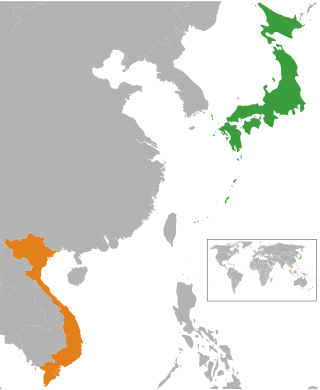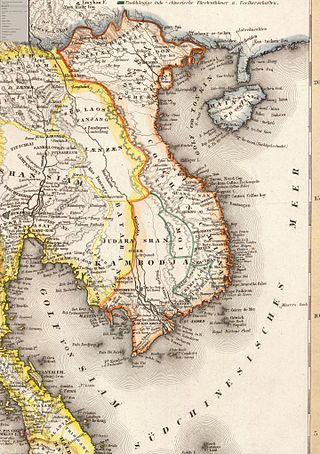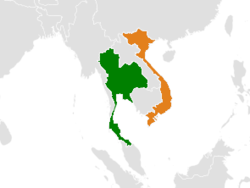The foreign relations of Thailand are handled by the Ministry of Foreign Affairs of Thailand.

As of April 2022, Vietnam maintains diplomatic relationships with 189 UN member states, State of Palestine and Sahrawi Arab Democratic Republic. In 2011 the Central Committee of the Communist Party of Vietnam, at the 11th National Congress of the Communist Party of Vietnam, released an official statement about Vietnam's foreign policy and a section of the statement stated: "Vietnam is a friend and reliable partner of all countries in the international community, actively taking part in international and regional cooperation processes. Deepen, stabilize and sustain established international relations. Develop relations with countries and territories in the world, as well as international organizations, while showing: respect for each other's independence; sovereignty and territorial integrity; non-interference in each other's international affairs; non-use or threat of force; settlement of disagreements and disputes by means of peaceful negotiations; mutual respect, equality and mutual benefit."

The Vietnam national football team represents Vietnam in men's international senior football and is controlled by the Vietnam Football Federation, the governing body of football in Vietnam. It has been nicknamed the Golden Star Warriors.

The Cambodian–Vietnamese War was an armed conflict between Democratic Kampuchea, controlled by Pol Pot's Khmer Rouge, and the Socialist Republic of Vietnam. The war began with repeated attacks by the Liberation Army of Kampuchea on the southwestern border of Vietnam, particularly the Ba Chúc massacre which resulted in the deaths of over 3,000 Vietnamese civilians. On 23 December 1978, 10 out of 19 divisions of Khmer Rouge's military divisions opened fire along the shared Southwestern borderline with Vietnam with the goal of invading the Vietnamese provinces of Đồng Tháp, An Giang and Kiên Giang. On 25 December 1978, Vietnam launched a full-scale invasion of Kampuchea, and subsequently occupied the country in 2 weeks and removed the government of the Communist Party of Kampuchea from power. In doing so, Vietnam put an ultimate stop to the Cambodian Genocide, during which 25% of the Cambodian population had already been executed under Pol Pot’s regime.

Army and warfare made their first appearance in Vietnamese history during the 3rd millennium BC. Throughout thousands of years, wars played a great role in shaping the identity and culture of people inhabited the land which is modern day Vietnam. Vietnam is regarded as one of the most militaristic countries in Southeast Asia, there is even a higher level belief Vietnam might be the most militaristic nation in Southeast Asia, and one of Asia and the world's most militaristic countries. The military history of today’s Socialist Republic of Vietnam began when Japan invaded French Indochina, they defeated the French resistance after nearly a hundred years of oppression and inspired many countries worldwide to take up the fight against foreign invaders. Since then, Vietnam has fought in many conflicts.

The military history of Thailand encompasses a thousand years of armed struggle, from wars of independence from the powerful Khmer Empire, through to struggles with her regional rivals of Burma and Vietnam and periods of tense standoff and conflict with the colonial empires of Britain and France. Thailand's military history, dominated by her centrality in the south-eastern Asian region, the significance of her far flung and often hostile terrain, and the changing nature of military technology, has had a decisive impact on the evolution of both Thailand and her neighbours as modern nation states. In the post-war era, Thailand's military relationship with the United States has seen her play an important role in both the Cold War and the recent War on Terror, whilst her military's involvement in domestic politics has brought frequent international attention.

Japanese–Vietnamese relations are over a millennium old, and the establishment of friendly trade relations can be traced to at least the 16th century. Modern relations between the two countries are based on Vietnam's developing economy and Japan's role as an investor and foreign aid donor, as well as migrant Vietnamese workers supplying much needed labour in Japan.

The Siamese–Vietnamese War of 1831–1834, also known as the Siamese-Cambodian War of 1831–1834, was sparked by a Siamese invasion force under General Bodindecha that was attempting to conquer Cambodia and southern Vietnam. After initial success and the defeat of the Khmer Army at the Battle of Kompong Cham in 1832, the Siamese advance was repelled in southern Vietnam in 1833 by the military forces of the Nguyễn dynasty. Upon the outbreak of a general uprising in Cambodia and Laos, the Siamese withdrew, and Vietnam was left in control of Cambodia.

The Siamese–Vietnamese War of 1841–1845 was a military conflict between the Đại Nam, ruled by Emperor Thiệu Trị, and the Kingdom of Siam, under the rule of Chakri King Nangklao. The rivalry between Vietnam and Siam over the control of the Cambodian heartlands in the Lower Mekong basin had intensified after Siam had attempted to conquer Cambodia during the previous Siamese–Vietnamese War (1831–1834). Vietnamese Emperor Minh Mạng installed Princess Ang Mey to rule Cambodia as a puppet queen regnant of his choice in 1834 and declared full suzerainty over Cambodia, which he demoted to Vietnam's 32nd province, the Western Commandery. In 1841, Siam seized the opportunity of discontent to aid the Khmer revolt against Vietnamese rule. King Rama III sent an army to enforce Prince Ang Duong's installation as King of Cambodia. After four years of attrition warfare, both parties agreed to compromise and placed Cambodia under joint rule.

Relations between Vietnam and China had been extensive for a couple of millennia, with Northern Vietnam especially under heavy Sinosphere influence during historical times. Despite their Sinospheric and socialist background, centuries of conquest by modern China's imperial predecessor as well as modern-day tensions have made relations wary. The People's Republic of China (PRC) ruled by the Chinese Communist Party (CCP) assisted North Vietnam and the Communist Party of Vietnam (CPV) during the Vietnam War whilst the Taiwan-based Republic of China (ROC) was allied with South Vietnam.

Cambodia–Vietnam relations take place in the form of bilateral relations between the Kingdom of Cambodia and the Socialist Republic of Vietnam. The countries have shared a land border for the last 1,000 years and share more recent historical links through being part of the French colonial empire. Both countries are members of the Association of Southeast Asian Nations (ASEAN).

Republic of Greece and the Socialist Republic of Vietnam have bilateral relations. Greece hosts the Vietnamese embassy in Athens, and Vietnam hosts its Greek counterpart in Hanoi.

Pakistan-Vietnam relations, or Pakistani-Vietnamese relations, refers to the bilateral relationship between the Socialist Republic of Vietnam and Islamic Republic of Pakistan. The relationship is largely based on mutual trade and international political cooperation between the two countries. Pakistan is represented in Vietnam by its embassy in Hanoi, and Vietnam also maintains an embassy in Islamabad. During the Cold War, Pakistan maintained close ties with the United States-led Western Bloc to counter rival India's allegiance with the Soviet Union and Eastern Bloc. Throughout the 1960s and 1970s, the United States was involved in the Vietnam War against Soviet-backed North Vietnam while in the same time period, Pakistan had engaged in two major wars with neighbouring India in 1965 and 1971, the latter of which resulted in a devastating defeat for Pakistan and saw the emergence of an independent Bangladesh. Due to the fact that Pakistan was an ally with the United States and had begun to indirectly wage war against the Soviets in Afghanistan with heavy U.S.−backing, relations became strained between the two, with Pakistan closing its diplomatic mission in Vietnam in 1980 and Vietnam doing the same in 1984. However, relations greatly improved in the 2000s, and Pakistan reopened its embassy in Hanoi in October 2000. Vietnam also reopened its embassy in Islamabad and trade office in Karachi in December and November 2005, respectively. Relations between the two countries have continued to remain friendly, with Vietnam expressing an interest in increased economic and military cooperation with Pakistan. The heads of both nations have in recent times paid official visits to each other, with Pakistani President Pervez Musharraf visiting Vietnam in May 2001 and Vietnamese President Trần Đức Lương also paying an official visit to Pakistan in March 2004. Throughout the following decade, several visits were made by various Vietnamese and Pakistani ministries to each other. A major part of Pakistan's pursuit to enhance its relationship with Vietnam is outlined in Pakistan's "Vision East Asia" strategy. The emergence of such a strategy came as a result of Pakistan's desire to balance its relations with Vietnam and other East Asian / Southeast Asian states by making an effort to circumvent Pakistan's close relationship with China and Vietnam's growing relationship with India—the former being a cause of concern for Vietnam due to its tense relationship with China and the latter being a cause of concern for Pakistan due to its rivalry and history of armed conflict with India.

Bilateral relations between Cambodia and Thailand date to the 13th century during the Angkor Era. The Thai Ayutthaya Kingdom gradually displaced the declining Khmer Empire from the 14th century, French protectorateship separated Cambodia from modern Thailand at the turn of the 19th–20th centuries, and diplomatic relations between the modern states were established on 19 December 1950.

North Korea–Vietnam relations is a bilateral relationship between Vietnam and North Korea. North Korea and the former country North Vietnam established formal diplomatic relations on January 31, 1950. In July 1957, North Vietnam President Ho Chi Minh visited North Korea; North Korean prime minister Kim Il Sung visited North Vietnam in November–December 1958 and November 1964. In February 1961, the two governments concluded an agreement on scientific and technical cooperation. North Vietnam merged with South Vietnam in 1976 to become the modern country of Vietnam.

The Siamese–Vietnamese wars were a series of armed conflicts between the Siamese Ayutthaya Kingdom and Rattanakosin Kingdom and the various dynasties of Vietnam mainly during the 18th and 19th centuries. Several of the wars took place in modern-day Cambodia.

Myanmar–Vietnam relations refer to the historical and current relationship between Myanmar and Vietnam. Both are members of the ASEAN and have engaged in relationship between two countries. Myanmar has an embassy in Hanoi and a consulate general in Hồ Chí Minh City while Vietnam maintains their embassy in Yangon.

Turkey–Vietnam relations refers to bilateral relations between Turkey and Vietnam. Turkey has an embassy in Hanoi and Vietnam has an embassy in Ankara, and a trade office in Istanbul.
Vietnamese irredentism, also known as Ideology of Greater Vietnam, sometimes may be referred to as Baiyue Nationalism is an irredentist and nationalist claim concerning redemption of former territories of Vietnam and territories outside Vietnam that the Vietnamese have inhabited for centuries. Notable claims are usually made concerning territories of Laos, Cambodia, and Liangguang of China.
The Vietnamese invasions of Cambodia refers to the period of Cambodian history, between 1813 and 1845, when the Kingdom of Cambodia was invaded by the Vietnamese Nguyễn dynasty three times, and a brief period from 1834 to 1841 when Cambodia was part of Tây Thành province in Vietnam, undertaken by Vietnamese emperors Gia Long and Minh Mạng. The first invasion that took place in 1811–1813 put Cambodia as Vietnam's client kingdom. The second invasion in 1833–1834 made Cambodia a de facto Vietnamese province. Minh Mạng's harsh rule of the Cambodians finally ended after he died in early 1841, an event which coincided with a Cambodian rebellion, and both which triggered a Siamese intervention in 1842. The unsuccessful third invasion of 1845 resulted in the independence of Cambodia. Siam and Vietnam signed a peace treaty in 1847, allowing Cambodia to reassert its independence in 1848.






















